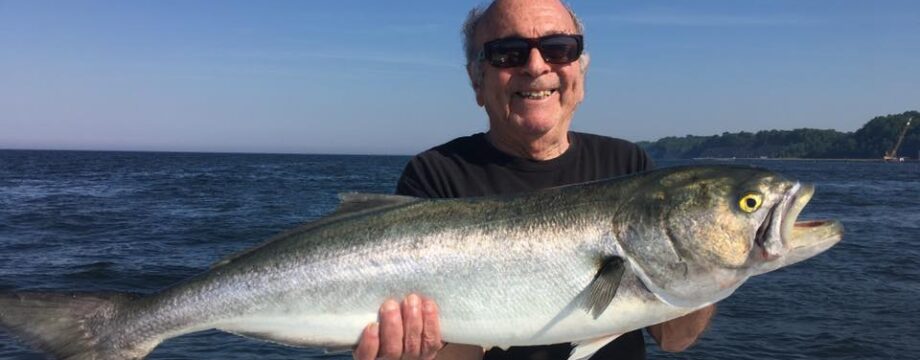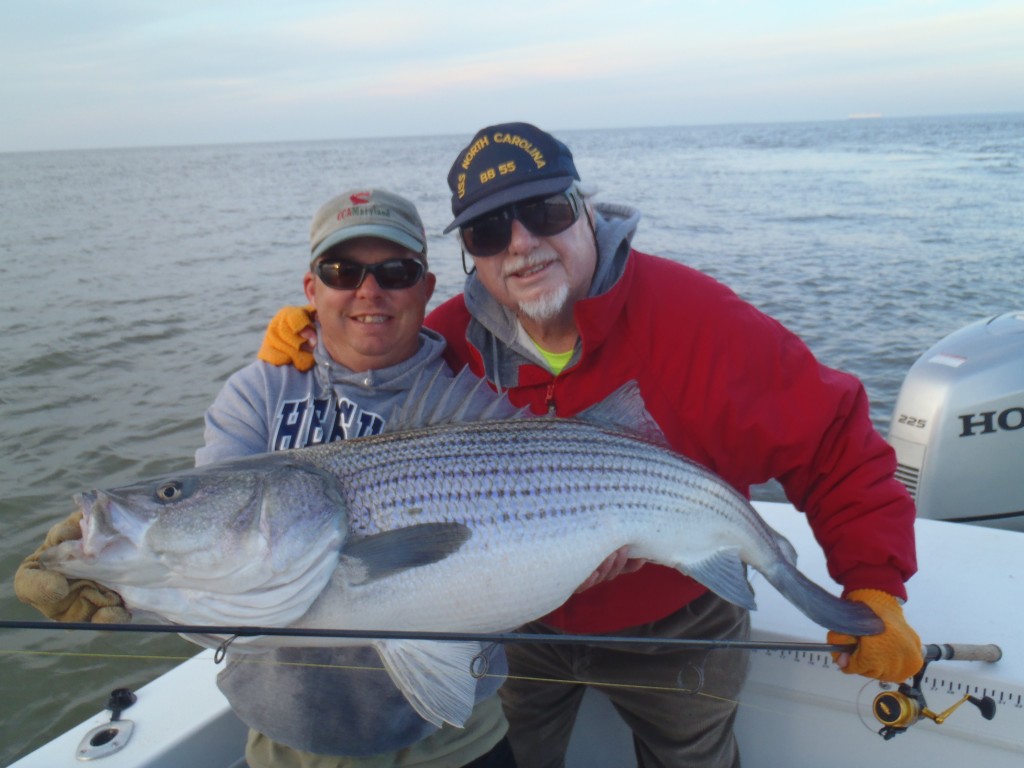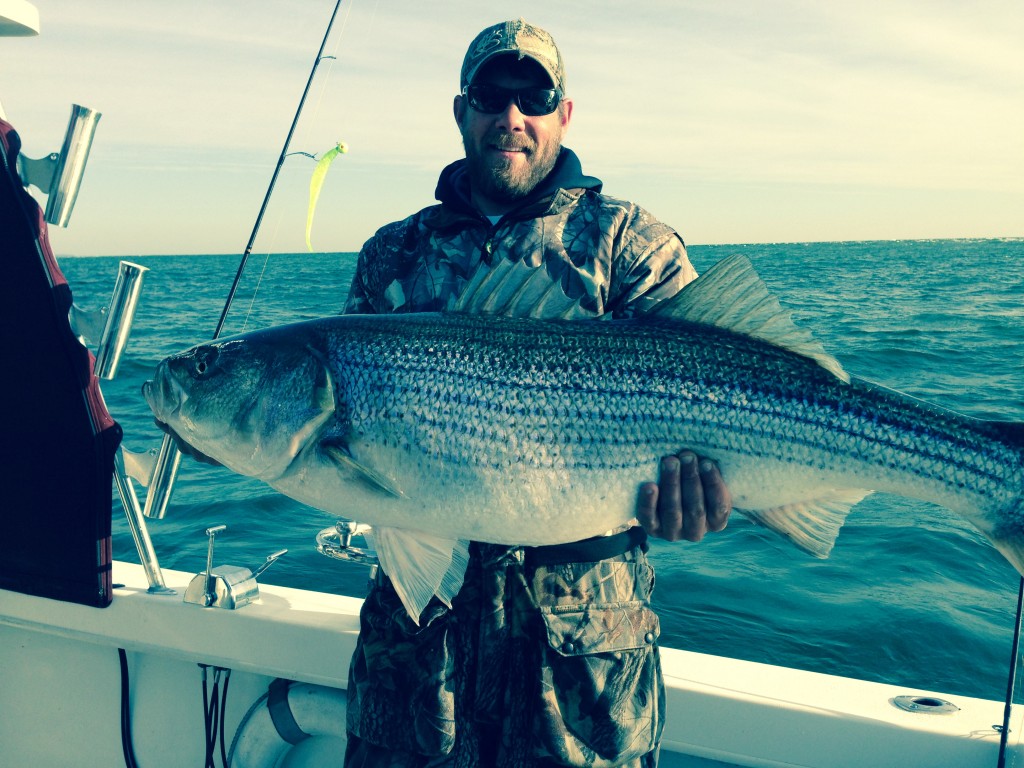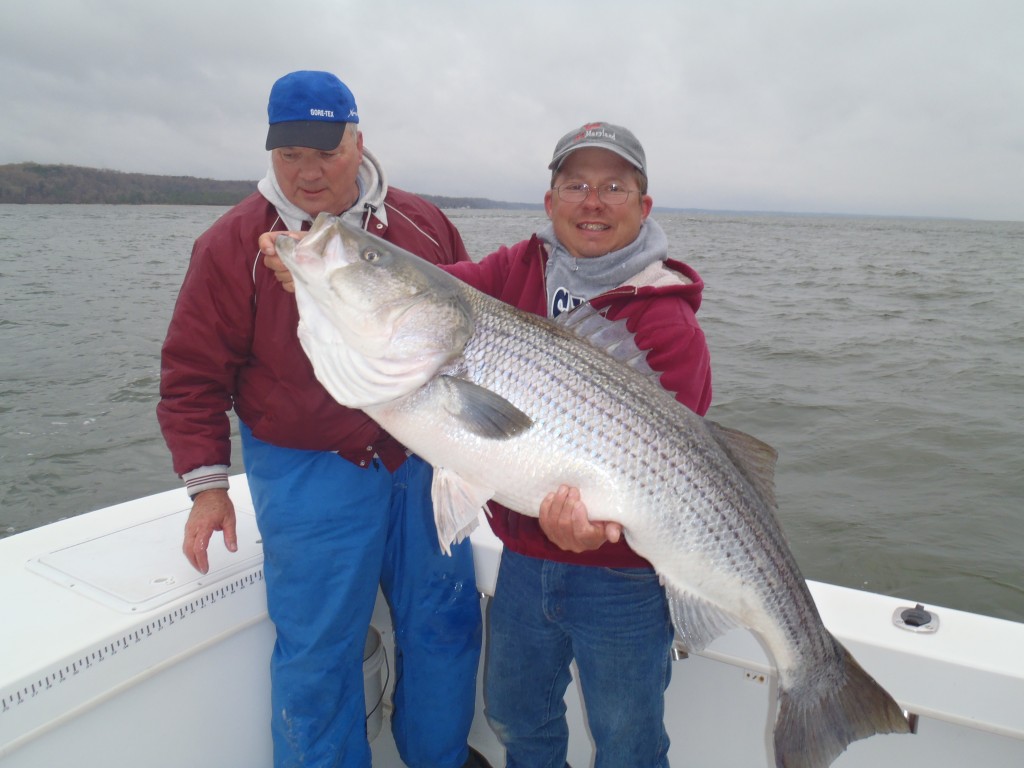
Rick Dell and I with an over 50″(about 51″) Striper he caught using a 10″ BKD loaded on a 1.5 ounce jighead
A Quick look Back
I moved to the Washington DC area in August of 1995, it didn’t take long for me to fall in love with Chesapeake Bay and it’s incredibly wonderful light tackle opportunities. By September I purchased a boat to fish Chesapeake Bay and begin to experience all it’s wonder. Stripers, Blues, Flounder, Weakfish and Croaker were abundant. Life and fishing was great and I fell deeply in love with Chesapeake Bay and it’s fishery. From 1996-1999 I was always taking friends fishing with great success and meeting some incredible folks. By late 1999 my fishing buddy Pete Dressler, AKA Superfish on Tidalfish.com talked me into the fact I could be a fishing guide on Chesapeake Bay. I was doubtful but open to thinking about it. Somewhere around Dec 1999 Steve Seigel (founder BKD’s) made it known he knew a guy selling his Maryland Guide license……long story short…..I bought it, took the OUPV 6 pack class, passed first try and started guiding at the Susquehanna Flats in April of 2000. As a full time military guy I only guided part time until my retirement from the Air Force in Nov 2004. Since 2004 I have guided anglers full time without a real job…….CRAZY!
How I Began At Calvert Cliffs
The winter of 1996 was mild I recall……I was dieing to fish but didn’t know where to go other than the power plant outflow up the Patuxant River called Chalk Point. We caught lots of white perch and catfish there…..was fun! While surfing the web on my new computer I found a fishing report on the Maryland DNR website. Marty Gary wrote an incredible story about Pete Dressler, an angler with great skill and passion who fished Calvert Cliffs Nuclear Power Plant all winter long starting in January. I was greatly intrigued and decided to go for it. I went out there on a gloomy day with wind light out of the west. Perfect day to be there even though it was chilly with bad visibility. I anchored up in the middle of the flow like the article said and I began to throw a jig. A bass assassin on a 1/2 jighead is what I had to throw. I didn’t catch anything because the jighead was to light, not getting the bait to the fish in the huge current. As I was slinging away another boat rolled out of the fogbank and slowly made his way up the rip and threw his anchor in the rip. Shortly his boat was about 20 yards off my port, his first cast was a fish on. Didn’t take long and he threw me over a bag with bigger jigheads. I tied one on and immediately I was catching right along side the “Superfish”. Shortly he yelled over to me and invited me to fish on his boat at a later date. I gave him my phone number and he called soon. We fished together for about 4 years straight very often. He taught me much about life. The one thing embedded in what I do in my business is this…… Pete Dressler told me to “be kind and give away as much as possible, it will come back 10 fold and you will always feel peace.” and another thought Pete preached to me is, ” life (and fishing) is like a game of poker, you don’t always get all high or low cards, the measure of a man is how he handles the low cards”. I sure do my best to live by these thoughts. Thanks Pete Dressler (RIP brother)!
From 1996 thru the present time I’ve fished every winter at Calvert Cliffs starting in January or later depending on wether or not Stripers were at the CBBT (Chesapeake Bay Bridge and Tunnel). The fishing techniques have changed for sure. Back in the 90’s it was common for a guy trolling to mow right up the outflow with cannon balls attached to some type of lures, never saw them catch a fish. The light tackle guys were mainly anchoring in the flow. You get there first you pick your spot and so on and so forth. As time moved along drifting while light tackle jigging and anchoring was a big controversy. Since no person owns the rips you could do anything you wanted. After the year 2000 and certainly in 2001 I drifted instead of anchoring. While anchored an angler had to be skilled at throwing across and up the current and detecting bottom without dragging. If you drag you snag quickly while in the boulders which line the bottom from the outlfllow to approximately 150 yards down the flow. After the boulders its an oyster shell/sand bottom. Can only imagine the jigheads down there! I tried guiding while at anchor at the power plant and it just wasn’t working consistantly.
How Its fished Now
My intention may be different from others. As a guide my mission at Calvert Cliffs Nuclear Power Plant is to get my folks sticks bent as quickly and efficently as possible. Whether the fish are huge or small it just doesn’t matter. One thing for sure at Calvert Cliffs is you can catch a small fish and then a huge fish in the same spot. Everyday can be different but it sure can be great! I like big baits like 10″ BKD’s and 6″ BKD’s. Normally my crews are folks who don’t have the opportunity to catch these fish on their own boat in the winter or would rather just let me drive my boat and leave their boat winterized and provide everything for them. Through the years my crews and I have had a blast catching big fish, medium fish and small fish. The great thing is HUGE fish are possible anytime you go there from Jan-Apr. The prime time for me on numbers of huge fish, 40″ and above is mid march – mid april. However, some great fish absolutely can be there in Jan and Feb. Some winters there are more fish than others…..ya just never know.
Click on the link below to see the last 5 years of great fish in a slideshow format. During the timeframe of these pics we would take pics of a couple of big fish per trip per person. On many trips dozens of huge fish were just caught and quickly released because we didn’t need more pics…….good stuff!
Calvert Cliffs, Marylands Striped Bass Off Season Catch and Release Heaven
The technique I typically use is drifting down the outflow with the engine off. I enter the side of the outflow from a perpendicular position, cut my engine as I enter the flow and the momentum takes me where I want to be. Right now 2 different techniques are used. Experienced folks will drift their boat on the outside of the current and cast at an angle upstream and well out into the flow. They hold their rod tip steady and wait to feel the tick of their 1.5, 2 or 2.5 ounce jighead to touch the bottom. Once detected a short (6″-12″), very sharp twitch along with the current moves the jig through the area fish at Calvert Cliffs in the winter hold. Once the jig is downstream and off the bottom they reel up and cast again. The farther the cast the more difficult it is to detect bottom and work the jig just off the bottom without getting snagged, unless you are out past the boulders. Quite a few (experienced at Calvert Cliffs) anglers use this technique with great success.
The Technique I use with incredible success with hundreds of trophy light tackle Stripers caught is drifting the current with my engine off. If I have a couple anglers with great skill on the boat or if we have rough seas I’ll cast into the flow without drifting in much. Drifting the flow with experienced and inexperienced folks alike have produced hundreds of trophy Stripers over 40″ with loads over 45″ and three “actually” at 50 or more”. ” I never weigh fish, don’t want to stress them by hanging them on a boga grip or similar thing.” It’s legal…….my choice to not.
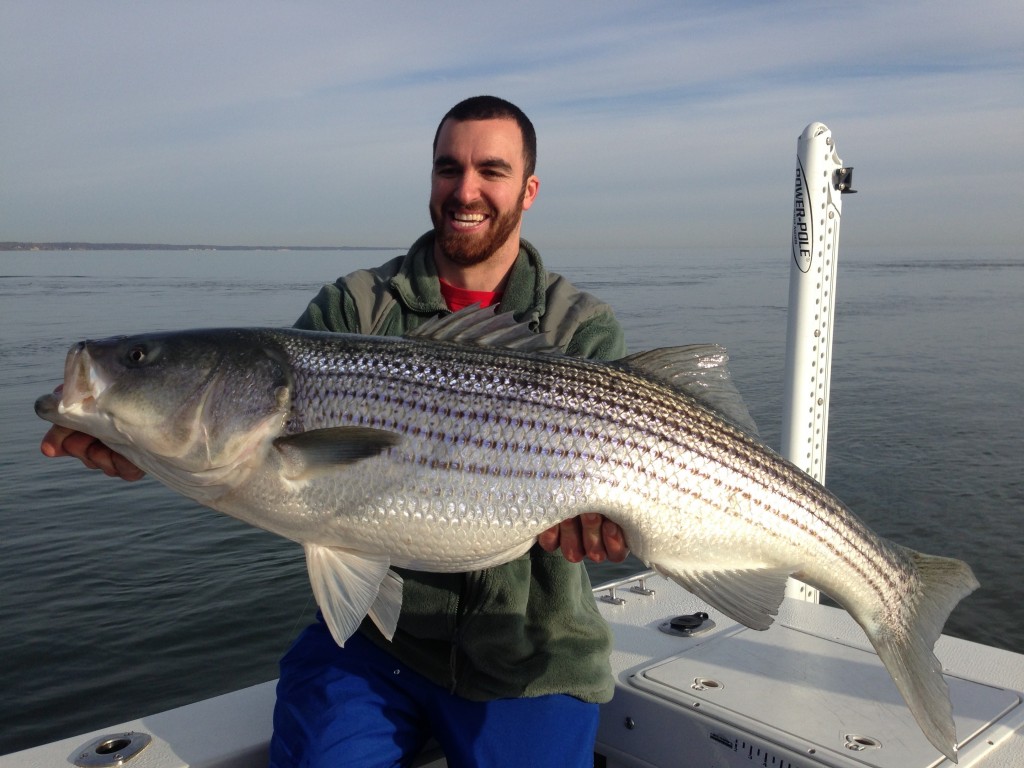 A “TRUE” 47″ Striper……weight unknown, probably around 42 pounds
A “TRUE” 47″ Striper……weight unknown, probably around 42 pounds
Detecting bottom at calvert cliffs is crucial! If the fish are thick and it’s crazy good it doesn’t matter. If the bite is difficult with not many fish then detection of bottom has to happen or typically you won’t catch. Slack line while jigging is ALWAYS wrong. If you have slack line you won’t detect bottom or a bite, you’ll miss hits and get snagged if in the boulders. Light tackle jigging anytime anywhere slack line is a huge no no. When on my boat I preach detecting bottom when jigging. Once we are in the flow I have anglers flip baits 10 yards or so off the boat, we either utilize a count or hold your index finger and thumb in a circle, line rolls off your reel and through your fingers. When you notice the line change it’s speed………HURRY…..click the bail, turn the reel one turn and start your short, sharp twitch technique. Almost always the Stripers hit when the jig is falling after the sharp twitch. I always preach a sharp twitch. The sharp twitch draws attention of the fish, then the fall is when they strike. If your line is not slack and you are using braided line you will feel the strike. It’s either a “tick” or a “thump”……I like the THUMP! Thump is the big ones!
Check out this trip on April 1st… We drifted over them all day! How the heck did that happen? April Fool’s Stripers
Catch and Release Is a Wonderful Thing-if it’s done right
Here’s what I think is best when catching and releasing Stripers at Calvert Cliffs Nuclear Power Plant in the winter.
-handle the fish without a net if possible
-lift the fish out of the water by lipping the fish. That is placing your thumb in the mouth and grabbing the lower lip……then as lifting out of the water place your other hand under the belly area to support the fish
-use single barbless hooks for a quick de-hook
-never drop a fish on the deck if possible
-hold the fish with a thumb in the mouth and hand under the belly area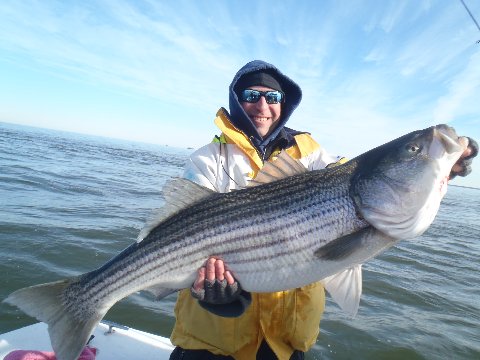
Thumb in the mouth, hand under the belly area, quickly release after a quick photo. Water under 60 degrees unless the fish is gill hooked and bleeding have a huge survival rate
-if you have hooked and caught a really huge fish and a prolonged fight occurred have one person lip the fish upon return to the water and one person hold around the area just above the tail. Once the fish is in the water the lip person lets go and the person holding the tail gently moves the fish back and forth. If the fish was badly winded it will absolutely come back strong quickly if you do this technique. When the fish is ready to go you will know….it will “kick out” of your grasp.

my buddy Alejandro Villanueva from the Pittsburgh Steelers with a “THUMPER”
He caught 5 over 40″ (he is 6’9″ 340) on this trip in 2015. This one was 46″……..awesome!
The rods I like are shore tackle custom sticks from 6’to 6.5′ medium action or medium heavy. You need enough stoutness to cast a heavy jighead and to hook a huge striper. A very fast tip is not what I like at calvert cliffs. Other stuff is fine, I like what I’m using. I like 3000 or 4000 size reels but lighter is fine with experienced anglers. I use 14 pound test flame green fireline and tie on a 30 or 40 pound test clear leader. Florocarbon not required. I don’t place swivels between my braid and leader. If I did my rods would come up with broken eyes all the time.
Important Notes about Fishing Calvert Cliffs
SAFETY! Winter time water temps are cold. Be prepared if you are running your own boat to be able to communicate it you have a problem. Make sure the best that you can your boat is in top running form. Boats are boats you never know. Have all safety equipment ready. On occasion several to 30 boats could be drifting the outflow when nice weather in march/april. Most times very few boats are there in Jan/Feb. On occasion some of the best fishing is happening at Calvert Cliffs when the weather is nasty/windy. Caution: if you don’t understant that area don’t go when the wind is over 15 knots out of the NNW, N, NE, E, ESE………when the wind is blowing out of the SE it still isn’t great but better, South is great, SW is best, W is great, NW is starting to get iffy and NNW it starts to get bad. Calvert Cliffs has approximately 2 milion gallons of water a minute coming out of the outflow…..it’s a HUGE current pushing very hard to the east. When the wind is against it the seas get horrible in there. When this is happending and you are there get on the downwind side of the outflow, bow into the edge of the flow, cast across the current with a 2 or more ounce jighead, detect bottom maybe and work the jig. One cast is all you get in windy conditions. DO NOT put your boat on the upwind side of the current in a heavy wind. If your boat is not real big or if you have a cut transom you could sink your boat quickly there if your boat won’t start and you get blown into the massive flow. It’s happened and it’s scarey! Be Careful!
Who Rules The Plant Fishing?
The state of Maryland does…….it’s an open place to catch and release Striped Bass out of the kill season. No person or organization can tell anyone how to fish there. Anyone can have an opinion on the best way to fish there.
Calvert Cliffs Nuclear Power Plant is not owned on the water by any group or single angler. If multiple boats are there understand your boat will drift and could drift real fast depending where you are in the flow. Wind, outflow current and tidal flow along with current eddies make drifting always a challange and you have to be aware of your surroundings. Always be polite to others and all will be great! It’s a good idea to not run your boat up the current to attempt to release a snag. Running engine over structure where the fish are in 18-30′ of water will probably spook fish. The plant has 2 million gallons of water pumping out of two (i think) pipes 20′ or so feet under water. At the outflow down about 150 yards is rip rap boulders on the bottom to help combat erosion. I can only imagine the noise all that friction from water coming out of pipes and blasting through boulders makes. 2 MILLION gallons a minute is a huge volume of water! With 18-30′ of water and all that craziness in the water allows for boats to drift over the fish without them leaving the area. (my 0pinion) If any human tells you they know anything for sure about what fish do in some situations they really don’t! Here’s what I know…….I DONT know! Especially in 18′-30′ feet of huge current and fish tight to the bottom! Drifting over the top of the flow at Calvert Cliffs has been a magical fishing experience for me and hundreds of folks I’ve taken to Calvert Cliffs over the last 16 years! Silence is best for sure, especially shallow without 2 million gallons flowing through a small area.
Here’s what we caught drifting over fish at Calvert Cliffs! Great video of light tackle jigging at Calvert Cliffs….check it out! Light Tackle Jigging Stripers On Chesapeake Bay in March!
What I explained above is the way I fish Calvert Cliffs and have for the last 16 years. Fortunately, I’ve had great success helping folks catch many of their best fish ever at Calvert Cliffs. Whether you fish with me or not I wish you well at Calvert Cliffs and please say hello if you see me out there in my Judge 27 Chesapeake named Four Seasons. If anyone has any questions feel free to text, call 703-395-9955 or email at Pete@walleyepete.com
I will be guiding at Calvert Cliffs through about April 15 give or take a little depending on the bite. My boat is very close to Calvert Cliffs for easy access. Right now the bite is on and off. Typically it gets great around mid march. I will be doing Walk-On trips or booked trips now through mid march when I think the bite is decent. If I don’t think we can catch decently I don’t guide. Starting around March 15 I will do two trips a day starting at 30 minutes prior to sunrise till 11 am….then in the afternoon from 2pm till dark. I’ve still got some availability but it’s filling up quick for march 15 and beyond. It’s a blast!
If you are interested in a trip or just have some questions feel free to contact me at 703-395-9955 or pete@walleyepete.com Thanks!

